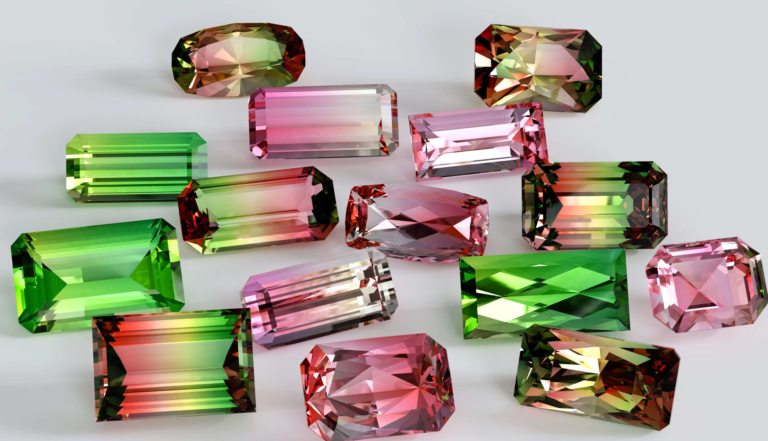October is a month renowned not only for its vibrant autumn colors but also for its unique and beautiful birthstones. Those born in October are blessed with the choice of two exquisite gemstones: the opal and the tourmaline. Each October birthstone boasts distinct characteristics and a rich history, making them special in their own right.
The Opal: A Gemstone of Mystique and Color
Origins and Characteristics
The opal, one of the October birthstones, is celebrated for its stunning play-of-color. This unique phenomenon involves a dazzling array of colors that shift and sparkle as the gemstone is moved. Opals come in various types, including white, black, and fire opals, each with its own unique charm.
Opals are formed from silica gel that hardens over time, creating a gemstone filled with a vibrant spectrum of colors. This play-of-color makes opal a one-of-a-kind gemstone, adding an element of intrigue and allure to any piece of jewelry.
Historical Significance
Throughout history, opals have been regarded as symbols of hope, purity, and protection. Ancient Romans and Greeks believed opals brought good fortune and protected the wearer from harm. In the Middle Ages, opals were thought to possess magical qualities, enhancing the owner’s abilities and bringing them good luck.
Today, the October birthstone opal continues to be cherished for its unique appearance and historical significance. It remains a popular choice for engagement rings, pendants, and other fine jewelry pieces.
Caring for Opal Jewelry
Opal is a relatively soft gemstone, making it essential to handle it with care. Avoid exposing opal jewelry to harsh chemicals or extreme temperatures. Clean opal with a soft, damp cloth and store it separately from other jewelry to prevent scratches and damage.
The Tourmaline: A Spectrum of Elegance
Origins and Characteristics
Tourmaline, another October birthstone, is known for its incredible variety of colors and remarkable durability. From vivid pinks and greens to deep blues and rich reds, tourmaline offers a broad spectrum of hues, making it a versatile and attractive choice for various types of jewelry.
Tourmaline is composed of complex boron silicate minerals and can be found in a variety of crystal shapes. This variety ensures that every piece of tourmaline jewelry is unique.
Historical Significance
Tourmaline has been valued by ancient civilizations for its protective qualities and was highly regarded by the Egyptians. They believed the gemstone had the power to dispel negative energy and offer spiritual protection. In the 19th century, tourmaline gained popularity in the United States after significant deposits were discovered.
Today, the October birthstone tourmaline is celebrated for its durability and vibrant colors. It is a popular choice for engagement rings and statement pieces due to its striking appearance and resilience.
Caring for Tourmaline Jewelry
Tourmaline is durable but still requires careful handling. Clean tourmaline jewelry with a mild soap solution and a soft brush. Avoid exposing it to harsh chemicals or extreme temperatures to maintain its luster and color.
Comparing the October Birthstones
Aesthetic Appeal
Both opal and tourmaline offer exceptional beauty but in different ways. Opal’s play-of-color creates a dynamic and mesmerizing visual effect, making each piece of opal jewelry truly unique. In contrast, tourmaline’s wide range of vibrant colors and ability to maintain its hue under various lighting conditions provide a classic, timeless elegance.
Durability and Use in Jewelry
Tourmaline is more durable than opal due to its higher hardness on the Mohs scale, which ranges from 7 to 7.5. This makes tourmaline a better choice for everyday wear compared to opal, which has a lower hardness level of 5.5 to 6.5. Consequently, opal is often used in jewelry that is less exposed to rough wear, such as pendants or decorative items.
Personal and Symbolic Significance
Both October birthstones carry significant meanings. Opal is associated with creativity, inspiration, and emotional healing. It is believed to enhance the wearer’s sense of self and personal expression. Tourmaline, on the other hand, is linked to protection, balance, and grounding.
Conclusion
Choosing between opal and tourmaline as your October birthstone comes down to personal preference and the qualities that resonate most with you. Opal’s mesmerizing play-of-color and historical significance make it a gemstone of intrigue and charm. Tourmaline’s vibrant colors and durability offer a versatile and enduring option for various types of jewelry.
FAQs
What are the main differences between opal and tourmaline as October birthstones?
Opal is known for its play-of-color and unique iridescence, while tourmaline offers a wide range of vibrant colors and greater durability. Opal is softer and more delicate, whereas tourmaline is more suitable for everyday wear due to its hardness.
How should I care for opal jewelry?
Opal jewelry should be cleaned with a soft, damp cloth and stored separately to avoid scratches. Avoid exposing opals to harsh chemicals or extreme temperatures to maintain their quality.
What makes tourmaline a good choice for jewelry?
Tourmaline is durable, available in a wide range of colors, and resistant to scratching and chipping. Its versatility and elegance make it a popular choice for various types of jewelry.
Can opal and tourmaline be used in engagement rings?
Yes, both opal and tourmaline can be used in engagement rings. However, due to opal’s softness, it is often recommended for designs less exposed to daily wear. Tourmaline, with its durability, is a more practical choice for everyday use.
What is the historical significance of opal and tourmaline?
Opal has been associated with hope, purity, and protection throughout history, while tourmaline was valued for its protective and grounding qualities. Both gemstones have rich histories and symbolic meanings.

